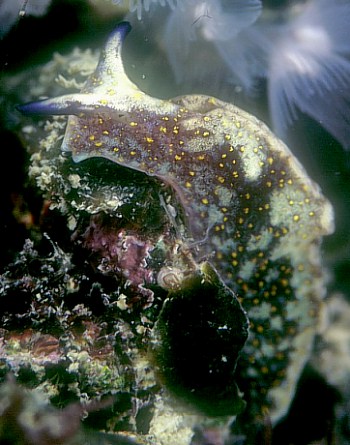
Elysia cf. japonica
Order: SACOGLOSSA
Superfamily: ELYSIOIDEA
Family: Elysiidae
PHOTO
Ping Chau, Hong Kong, 4m, 2 April 2001. Photo: Leslie Chan
Kathe Jensen (see message below) has tentatively identified this species as Elysia japonica Eliot, 1913. See continuing discussion below, and copy of Eliot's original description.
Reference:
• Eliot, C.N.E. (1913) Japanese Nudibranchs. Journal of the College of Science, Tokyo Imperial University, 35: 1-47.
Rudman, W.B., 2001 (July 16) Elysia cf. japonica [In] Sea Slug Forum. Australian Museum, Sydney. Available from http://www.seaslugforum.net/find/elyscfjapo
Related messages
Sap-sucking Sea Slug from Singapore
November 10, 2008
From: Toh Chay Hoon
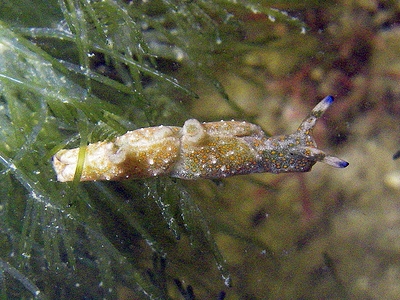
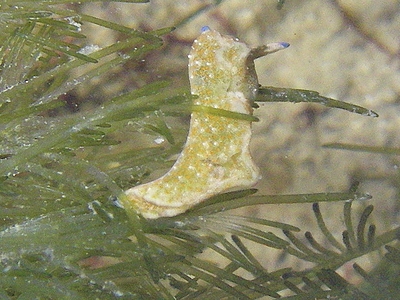
Dear Dr Bill,
I came across this sap-sucking sea slug on a submerged reef off Southern Singapore during an intertidal trip. It was found on Bryopsis algae. Would you kindly help with its ID?
Locality: Cyrene Reef, intertidal, Singapore, South China Sea, 16 October 2008, Intertidal. Length: 5 mm. Photographer: Toh Chay Hoon.
Thank you,
Chay Hoon
sonnenflower@gmail.com
Toh C.H, 2008 (Nov 10) Sap-sucking Sea Slug from Singapore. [Message in] Sea Slug Forum. Australian Museum, Sydney. Available from http://www.seaslugforum.net/find/21996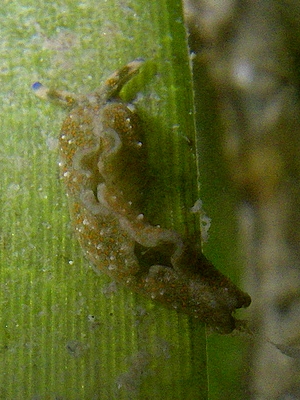
Dear Chay Hoon,
We have this on the Forum as Elysia cf. japonica but if you look at the discussions under that species and Elysia abei there is still no clear agreement on whether they are all colour forms of one species or not. Certainly the blue on the rhinophores and the distinct yellow spots are characteristic of Elysia cf. japonica, but we are not sure if it is the same as Elysia japonica or E. abei, or both.
Best wishes,
Bill Rudman
Elysia cf. japonica - another photo
September 10, 2002
From: Nishina Masayoshi
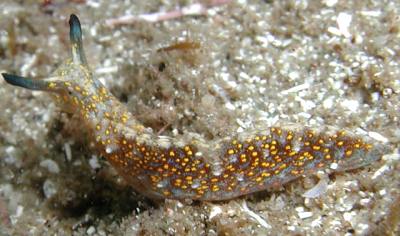
Dear Bill,
Here is another photo of the Elysia your are calling Elysia cf. japonica.
Data: Echizen coast, Japan. 3 August 2002. R. Nakano.
Nishina Masayoshi
nishina@wips.co.jp
Masayoshi, N., 2002 (Sep 10) Elysia cf. japonica - another photo. [Message in] Sea Slug Forum. Australian Museum, Sydney. Available from http://www.seaslugforum.net/find/7865Thanks Nishina,
Bill Rudman
Elysia in Echizen cost
May 23, 2002
From: Nishina Masayoshi
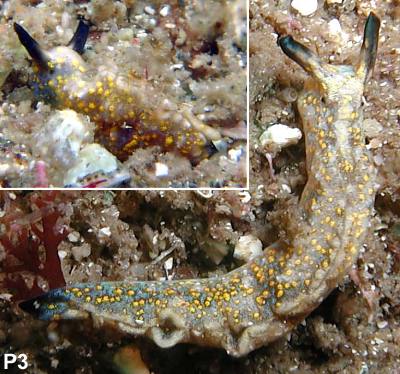
Dear Bill,
We photographed many Elysia in Echizen coast in last summer(11,12 Aug 2001) and I have divided them into following groups from external features.
• P1. Translucent colourless body with white and yellow glandular? patches. Posterior foot and rhinophores are blue-black-tipped (sometimes speckled with white). [Attached images: P11,P12].
• P3. Similar to P1 but some green pigment present.
• P4. Similar to P1 but most of body with green pigment. White papillae on parapodia. [Attached images: P41, P43]
• P5. Similar to P1 but body dark green. White papillae on parapodia. [Attached images: P51,P52]
They have similarities to Elysia japonica, Elysia amakusana, Elysia abei and even Elysia cf. furvacauda. They were photographed almost on the same day and the same place on the Echizen coast. They were all approximately 10mm long.
I have no idea how to tell these animals apart. Although the body color is different, external features are all similar to each other. I feel that the white papillae on the parapodia and the white specks sometimes on the rhinophores can not be special external features for separating these animals. But I cannot say anything about their anatomy.
Best Regards,
Nishina Masayoshi
nishina@wips.co.jp
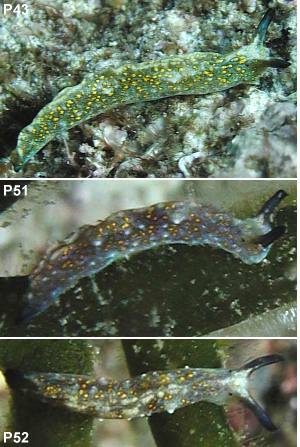

Dear Nishina
Sorry it has taken me a while to post this message. I have no problem in considering all these animals to be colour forms of one species. The differences in the amount of green pigment being almost certainly related to the amount of algal pigment in their branching digestive gland ducts. I am sure that this is the animal the Kathe Jensen considers is Elysia japonica.
The animal I have on the Forum as Elysia abei could well be an even darker colour form of your Elysia. Whether I have correctly identified it as E. abei is a separate problem for us to solve. Similarly, I don't know if the animal on the Forum as Elysia amakusana is correctly identified. From the photos on the Forum it seems that it could be different. There seems to be quite a dense cover of pigmentation on the skin, and the papillae are much more extensive than the arrangement on the animal in your message.
The problem then is, what is the best name for this species, and if we can correctly identify E. amakusana and E. abei, are they the same or different?
Best wishes,
Bill Rudman
Re: Original description Elysia japonica
March 28, 2002
From: Kathe R. Jensen
Dear Bill,
I thought I had said this before, but when I checked my earlier message it was not there: Besides the black tips of rhinophores and tail I also used the distinct constriction of the pericardial hump and the parallel posterior vessels lining a band apparently with no digestive gland tubules to identify my Hong Kong specimens with Elysia japonica. Baba did not mention these characters in his descriptions of E. amakusana and E. abei, but the radular teeth of these two species seem identical, and also identical to my Hong Kong specimens.
Greetings,
Kathe
jensen@ait.ac.th
Jensen, K.R., 2002 (Mar 28) Re: Original description Elysia japonica. [Message in] Sea Slug Forum. Australian Museum, Sydney. Available from http://www.seaslugforum.net/find/6591Thanks Kathe,
Your mention of the constriction in the pericardial hump etc to add some weight to your suggestion that this animal could be Elysia japonica. I guess we have to see if anyone can find a specimen of it in Japan, and find out whether either of the other potential candididates for the name, E. amakusana and E. abei, have a constriction on the pericardial hump and similar dorsal vessels.
Inadequate descriptions are a pain,
Bill Rudman
Original description Elysia japonica
March 27, 2002
From: Nishina Masayoshi
Dear Bill,
If you have the original description of Elysia japonica Eliot, 1913, Please let me know. I would like to know especially about its external characters.
Best Regards,
Nishina Masayoshi
nishina@wips.co.jp
Dear Nishina,
Eliot (1913) published a paper based on preserved specimens in the collections of the Imperial University, Tokyo. Some species seem to have been accompanied by colour sketches, but for many of the specimens there seems to have been no accompanying information on the living animal. The specimens of Elysia japonica fall into that category. As I said earlier there seems to be no way we can easily identify Eliot's species.
Eliot's description is relatively short so I have copied it below:
======================
Elysia japonica sp. nov.
18 specimens. Locality? (No label found). The largest is about 20mm long and the wings are moderately ample. In two specimens which were dissected, the radula was found to contain six teeth in the ascending row, 15 in the descending and about 20 more of various sizes lying in a heap. The structure of the radula and the shape of the teeth is as usual in the genus. No denticles are to be seen. I think that this form is probably a new species distinguished by the following characters:
(1) Colour: In all the specimens the rhinophores and the tip of the tail are conspicuously black or very dark brown. Otherwise the colour is uniform and in the best preserved specimen is yellowish brown. The wings have no coloured borders and the head and pericardium are of the same colour as the dorsal surface.
(2) The arrangement of the dorsal surface. This is similar in all the specimens and I have not seen it in any other species. The pericardium is not ovate but is constricted in the middle. Its length is greater than its breadth but it is short in comparison with the length of the whole animal. The dorsal ridges which run into it are very distinct and the two hindmost, which run backwards towards the tail, are parallel to one another and enclose an area which is differentiated from the back and forms a smooth trench.
• Eliot, C.N.E. (1913) Japanese Nudibranchs. Journal of the College of Science, Tokyo Imperial University, 35: 1-47. [pp46-7]
========================
There are no illustrations. Basically we do not know what the animal looks like alive, where in Japan it was collected, or anything meaningful about its anatomy. My feeling is that this name is unidentifiable and should be ignored. It is possible that some of the original specimens still exist. If so I guess it might be possible to dissect them and see if there are any recognisable anatomical characters which could be used to identify the species. If the original type material is shown to be lost then it is possible under the International Rules for a research worker to choose another specimen and designate it to be the neotype of the species. However since neither we, nor Eliot, had any idea of the animal's colour or where it came from in Japan, it seems better to just ignore his name.
Best wishes,
Bill Rudman
Elysia from Hong Kong
July 19, 2001
From: Leslie Chan

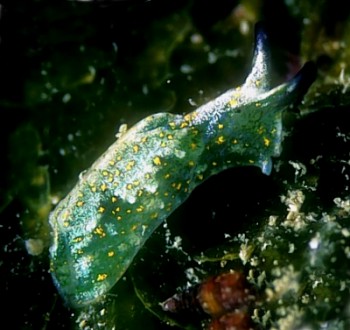
Dear Bill,
Could you identify this nudibranch which I photographed in Hong Kong.
Details: UPPER PHOTO: 4m, Ping Chau, Hong Kong, 2 April 2001, LOWER PHOTO: 8m, Tsim Chau, Hong Kong. 24 September 2000.
Thanks
Leslie Chan
leslie@lesmart.com
Chan, L., 2001 (Jul 19) Elysia from Hong Kong. [Message in] Sea Slug Forum. Australian Museum, Sydney. Available from http://www.seaslugforum.net/find/4757Dear Leslie,
I asked Kathe Jensen for advice on this one. She thinks it is possibly Elysia japonica. Have a look at her separate message.
Best wishes,
Bill Rudman
Leslie Chan's Elysia from Hong Kong
July 19, 2001
From: Kathe Jensen
Dear Bill,
I am pretty sure Leslie Chan's Elysia is what I have been calling Elysia japonica Eliot, 1913. It is difficult to see the tip of the tail, but I think it is also black/ dark (like tips of rhinophores). The species varies in colouration depending on the food alga - I have seen pinkish specimens, but unfortunately the diver who collected these specimens did not collect any algae, so I don't know if it actually eats red algae. The yellow dots may be more conspicuous, and there may be orange and iridescent blue dots as well. Also it may have more dark brown pigment on the parapodia. Usually it feeds on Cladophora and similar green algae.
A similar looking species, Elysia flavomacula Jensen, 1990, has one large yellow spot on the neck, and is generally much paler than this one. The rhinophores appear thicker and not narrowing towards the tips, and it does not have a black tip of the tail. Also, radular teeth are completely different, being blade-shaped in E. flavomacula and with rounded tips and lateral flanges in E. japonica.
I hope this will be sufficient information. At the time I described the Hong Kong specimens, I thought they looked very similar to the species Brian Brandley worked on and identified as E. furvacauda. After examining the type specimen of this species in the Museum of Victoria, I am not
so sure about that (or maybe Brian Brandley was not using E. furvacauda?).
• Jensen,KR (1985): Annotated checklist of Hong Kong Ascoglossa (Mollusca: Opisthobranchia), with descriptions of four new species. In: Proceedings of the 2nd International Workshop on the Malacofauna of Hong Kong and Southern China, Hong Kong, 1983. (Eds: Morton,B; Dudgeon,D) Hong Kong University Press, Hong Kong, 77-107.
• Jensen,KR (1990): Three new species of Ascoglossa (Mollusca, Opisthobranchia) from Hong Kong, and a description of the internal anatomy of Costasiella pallida Jensen, 1985. In: Proceedings of the 2nd International Marine Biological Workshop: The marine Flora and Fauna of Hong Kong and Southern China, Hong Kong, 1986. (Ed: Morton,B) Hong Kong University Press, Hong Kong, 419-432.
Greetings,
Kathe
jensen@ait.ac.th
Jensen, K., 2001 (Jul 19) Leslie Chan's Elysia from Hong Kong. [Message in] Sea Slug Forum. Australian Museum, Sydney. Available from http://www.seaslugforum.net/find/4796Thanks Kathe,
One value of the Forum is that by building up a collection of colour photos of these species it must surely help to sort out some of the names of the similarly coloured species. I note in your 1985 Hong Kong paper that you suggest that both E. amakusana and E. abei are both probably synonyms of E. japonica. If the identifications on the Forum, based on Japanese usage, are correct then it seems that they are probably distinct species.
I am a little bit concerned with your suggestion that it is possible to identify Eliot's Elysia japonica. The colour description was made from apparently preserved animals
"In all the specimens the rhinophores and tip of tail are conspicuously black or very dark brown. Otherwise the colour is uniform and the best preserved specimen is yellowish brown ....".
If as you say, the radular description is not likely to be accurate, then we have no information in Eliot's description on which to base an identification other than that it was from Japan. I feel it would be better to discard Eliot's name as unidentifiable and use a later name if there is one.
Concerning the species Brian Brandley worked with. There is no problem with identifying it. the problem is whether it has a name. While he was working on this species, he asked me for help in identifying it. It had previously been tentatively identified as E. furvacauda in New South Wales, but I felt it had significant differences to the original description by Burn. Unfortunately no material was available of 'typical' E. furvacauda for comparison. For this reason I suggested Brian identify his animal as Elysia cf. furvacauda and deposit voucher specimens in the Australian Museum collections. I photographed these specimens alive - see top of Elysia cf. furvacauda page - so that they would be identifiable to later workers. Throughout the paper they are referred to as Elysia cf. furvacauda and the identification problem discussed.
Best wishes,
Bill Rudman
